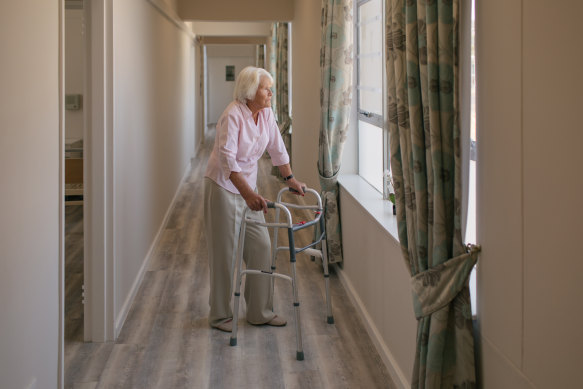By David Crowe
A funding crisis is tipped to leave older Australians without thousands of aged care places over the next five years because providers will not invest under the current federal rules, building pressure on Labor and the Coalition to strike a deal on a new regime.
The shortage could leave the sector without 21,200 beds as residential aged care operators warn of financial pressures that will force them to close more homes than they build.

The cost of residential aged care is rising.
A political impasse is also delaying a deal on federal funding for more Home Care plans that support older Australians to stay in their homes amid frustration that people can wait six months or more for the packages to be approved.
Aged care providers say they lost $5 billion over the past five years and will lose even more unless Labor and the Coalition agree within weeks to act on the findings of a damning royal commission into the sector three years ago.
“People have been holding on by a thread, and we have started to see the trickle of closures grow,” said Tom Symondson, chief executive of the Aged and Community Care Providers Association.
“We’ve started to see that with some operators, even if they don’t close the home when someone moves out, they don’t fill the bed and they shut it.
“That is starting to increase and we are well past it being a trickle to it being a waterfall or a torrent because people have been hanging on too long. How many industries do you know that have lost $5 billion over five years that are in a good shape? Because that, to me, indicates we’re not in a good place at all.”
A federal government aged care taskforce warned last year that the sector would need a $37 billion investment boost by 2050 to build enough places and services, but Labor and the Coalition could not reach a deal on the reforms in parliament last week despite intense negotiations.
The changes being negotiated in parliament, but which have not been publicly released, include funding changes to expect Australians with more assets to pay a greater share of their everyday costs, but not for nursing and clinical care.
The industry estimates that someone on the full pension would pay $62 per day and the federal government would add about $10 to that, but providers would still lose money at least $10 per person per day and sometimes three times that amount.
A member of the taskforce, Grant Corderoy of accounting firm Stewart Brown, estimated that providers would add 11,500 beds in the six years to 2030 but would close 32,700 over the same period, resulting in a deficiency of 21,200 beds.
Corderoy said the demand for residential aged care had softened in the past few years due to a big increase in Home Care packages, but was still outstripping supply.
“The financial losses over the past five years – an aggregate of over $5 billion – have created a lack of investment in the sector for new build and refurbishment, which is causing a further erosion of supply to meet future demand,” he said.
Prime Minister Anthony Albanese and Opposition Leader Peter Dutton have both said the industry needs a new set of laws to act on the royal commission, while Aged Care Minister Annika Wells has been negotiating with Coalition shadow minister Anne Rushton.
Council on the Ageing chief Patricia Sparrow said the new laws needed to pass this year to give all sides a better system to address shortages and act on the findings of the royal commission.
“The current uncertainty about what the future of aged care looks like is causing anxiety among older Australians,” she said.
“People deserve certainty so they can plan for the future. We need to see the detail of the legislation introduced into parliament in early September, so that older people can have a voice in the conversation through the Senate Inquiry process and in order for it to be able to be passed this year.
“Older Australians will want to have a say on whether the package is fair, affordable, easy to understand, transparent, equitable, and includes a strong safety net so that no one gets left behind.”
With parliament due to resume on September 9, the industry wants Albanese and Dutton to seal an agreement early in that week, allowing enough time for a Senate inquiry to iron out any problems so the law could be passed by the end of the year.
The draft changes would require wealthier Australians to pay more for non-clinical services such as food and laundry, but there is no agreement yet on an assets benchmark to decide how many people have to pay more.
The draft sets out options such as charging some older Australians $19 a day for their everyday costs as well as a separate $30 a day for accommodation, offering more private funding to providers in addition to government support.
The federal outlays on aged care amounted to about $1000 per person last year, but the taskforce said this would rise to $3000 per person per year over the next four decades.
Taxpayer funding in 2022 included $14.6 billion for residential care, $4.4 billion for Home Care packages and $2.9 billion for the Commonwealth Home Support Program. The total funding is forecast to double in real terms over a decade.
Cut through the noise of federal politics with news, views and expert analysis. Subscribers can sign up to our weekly Inside Politics newsletter.